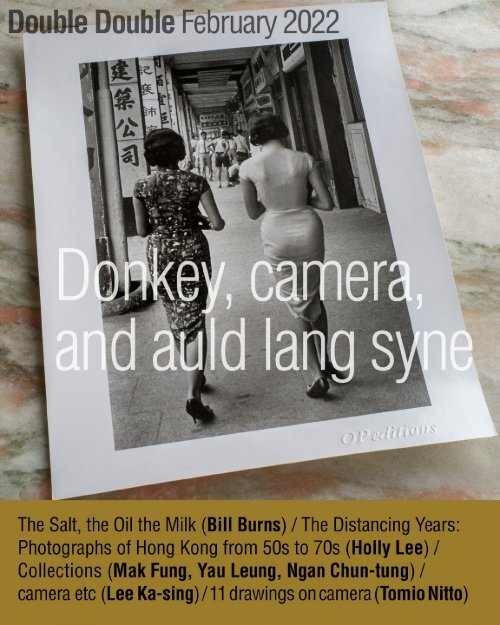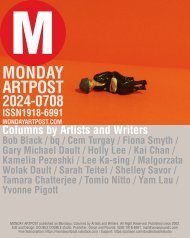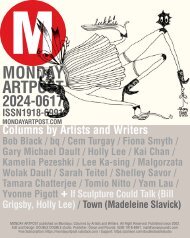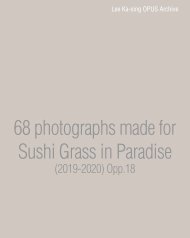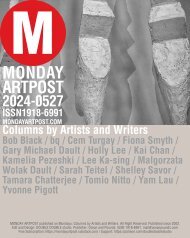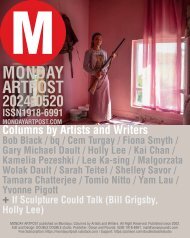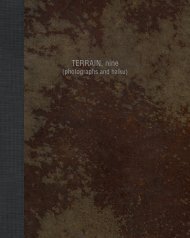Donkey, camera, and auld lang syne Trailer
There are three distinctive features in the February edition of DOUBLE DOUBLE: drawings, photographs and cameras. It opens with a project by Canadian artist Bill Burns - a cross-media work titled The Salt, the Oil the Milk. This project is about trade, animals, advanced industrialism, and exchanges; things that change hands, from small, minuscule dealings to large international transactions. An on-going and developing work incorporating performance, drawings and sculptures, it has been shown in cities in Europe, Argentina, New York, Toronto and Vancouver. Echoing Bill Burns’ drawings is Tomio Nitto’s suite of camera drawings. The illustrator once said that he could sketch faster than a camera. But soon after he started the drawing project he retracted his words. He found that the camera was not just a square box and a lens; each connection switch, each dial and button had incredible details. He later commented, “The camera has a beauty, and in my simple drawings, I make beauty too.” At length, beauty exists in all things - including man-made. Lee Ka-sing responded to Tomio’s camera drawings by photographing four of his cameras. As he was writing about his cameras, a lot of past stories scurried back across his mind. Good old time it was. We bring back some of those moments in the middle section of this book, showing a collection of photographs of Hong Kong in the second half of the twentieth century, all of which taken by three veteran photographers: Mak Fung, Ngan Chun-tung and Yau Leung. Photographs and cameras, they complement each other.
There are three distinctive features in the February edition of DOUBLE DOUBLE: drawings, photographs and cameras.
It opens with a project by Canadian artist Bill Burns - a cross-media work titled The Salt, the Oil the Milk. This project is about trade, animals, advanced industrialism, and exchanges; things that change hands, from small, minuscule dealings to large international transactions. An on-going and developing work incorporating performance, drawings and sculptures, it has been shown in cities in Europe, Argentina, New York, Toronto and Vancouver.
Echoing Bill Burns’ drawings is Tomio Nitto’s suite of camera drawings. The illustrator once said that he could sketch faster than a camera. But soon after he started the drawing project he retracted his words. He found that the camera was not just a square box and a lens; each connection switch, each dial and button had incredible details. He later commented, “The camera has a beauty, and in my simple drawings, I make beauty too.” At length, beauty exists in all things - including man-made.
Lee Ka-sing responded to Tomio’s camera drawings by photographing four of his cameras. As he was writing about his cameras, a lot of past stories scurried back across his mind. Good old time it was. We bring back some of those moments in the middle section of this book, showing a collection of photographs of Hong Kong in the second half of the twentieth century, all of which taken by three veteran photographers: Mak Fung, Ngan Chun-tung and Yau Leung. Photographs and cameras, they complement each other.
Create successful ePaper yourself
Turn your PDF publications into a flip-book with our unique Google optimized e-Paper software.
Double Double 2022-02
DOUBLE DOUBLE 2022-02<br />
<strong>Donkey</strong>, <strong>camera</strong>, <strong>and</strong> <strong>auld</strong> <strong>lang</strong> <strong>syne</strong><br />
A Holly Lee <strong>and</strong> Lee Ka-sing Publication<br />
First published in Canada by OCEAN POUNDS<br />
February 2022<br />
Library <strong>and</strong> Archives Canada Cataloguing in Publication<br />
Photography, Visual Art, Poetry, Literature, Culture<br />
Authors: Lee Ka-sing, Holly Lee, Bill Burns, Tomio Nitto<br />
ISBN: 978-1-989845-25-7<br />
Copyright © Ocean Pounds 2022<br />
Individual Copyrights belongs to the Artists <strong>and</strong> Writers.<br />
All Rights Reserved.<br />
For information about permission to reproduce material from<br />
this book, please write to mail@oceanpounds.com<br />
DOUBLE DOUBLE was published as a weekly webzine from<br />
January 2019 to December 2021. A total of 158 issues were<br />
published. Full archives available online:<br />
https://oceanpounds.com/blogs/doubledouble<br />
Some of the issues were re-packaged <strong>and</strong> published as<br />
print-on-dem<strong>and</strong> paperback editions.<br />
Since January 2022, DOUBLE DOUBLE has become a<br />
monthly publication, released in both paperback (POD) <strong>and</strong><br />
e-book versions, available for orders online at BLURB<br />
(blurb.com), or at OCEAN POUNDS in Toronto.<br />
Design <strong>and</strong> editorial by DOUBLE DOUBLE studio<br />
www.doubledouble.org<br />
<strong>Donkey</strong>, <strong>camera</strong>,<br />
<strong>and</strong> <strong>auld</strong> <strong>lang</strong> <strong>syne</strong><br />
Subscribe <strong>and</strong> Support<br />
https://patreon.com/doubledoublestudio<br />
Cover: a photograph by Yau Leung<br />
End Pages: Lee Ka-sing<br />
Some artwork featured in this publication might be available<br />
through OCEAN POUNDS<br />
(contact by email at mail@oceanpounds.com)<br />
OCEAN POUNDS<br />
50 Gladstone Avenue, Toronto,<br />
Ontario, Canada M6J 3K6<br />
www.oceanpounds.com
Bill Burns<br />
The Salt, the Oil<br />
the Milk
The following pictures are about my long-duration performance work called The Salt, the Oil the<br />
Milk. They tell about how the things we trade between each other, often called commodities,<br />
produce meaning. The first picture - of a promotional poster on a street in Sao Paulo - is followed<br />
by a group of pictures of a live performance, which is followed by a group of drawings about animals<br />
<strong>and</strong> advanced industrialism. The performance took place at the Oculus Pavilion in Toronto. The<br />
performance involved four goats, three goat farmers, a litre of goat’s milk, three Georgian chanters,<br />
a new song about the largest corporations in the world, two donkeys who carried salt, two donkey<br />
keepers, a brass b<strong>and</strong>, a beekeeper, many bees, a jar of honey, a master of ceremonies, a producer,<br />
many artists <strong>and</strong> observers, <strong>and</strong> several kilograms of salt. At the end of the day I mixed milk, honey<br />
<strong>and</strong> salt together. This was called “The Mixing of the Milk <strong>and</strong> Honey <strong>and</strong> Salt”.<br />
This salt, the several kilograms of salt that the two donkeys carried, came from the Windsor Salt<br />
Company which operates salt mines located at a large deposit under Detroit, Michigan <strong>and</strong> Windsor,<br />
Ontario. This salt was unloaded at a modern concrete building, whose floating roof has a big hole<br />
in the middle, known as the Oculus Pavilion. The Oculus Pavilion is located on the banks of the<br />
Humber River on the traditional l<strong>and</strong>s of the Anishinaabe, including the Mississaugas of the Credit,<br />
Haudenosaunee, <strong>and</strong> Huron-Wendat. This part of the Humber River is traditionally known as the<br />
Toronto Carrying-Place <strong>and</strong> has been an important trading area for about 11,000 years. The brass<br />
b<strong>and</strong> played songs about love <strong>and</strong> tears while the Georgian Chanters sang about industry, chickens<br />
<strong>and</strong> bees.<br />
The reader will not be surprised to learn that people have been trying to figure out what our things<br />
mean, how trading them creates tension, <strong>and</strong> why their value keeps changing for a long, long time.<br />
I am not the first to suggest that how we value <strong>and</strong> underst<strong>and</strong> things, whether trees, honey bees, or<br />
microwave ovens, is tied intimately to knowledge, technology <strong>and</strong> mythology. Some of my pictures<br />
are documents of events that have already occurred while others should be considered pre-documents<br />
because they are about events that have not yet occurred. My small contribution builds on the work of<br />
many people including fishers, farmers, w<strong>and</strong>erers, anthropologists, economists, <strong>and</strong> of course artists.<br />
Bill Burns<br />
Vancouver, February 2022
The following pages are of drawings by Bill Burns,<br />
from his cross-media work The Salt, the Oil the<br />
Milk. Eighteen water-colour <strong>and</strong> pencil drawings<br />
on paper, approximate size: 145 mm x 192 mm.
Bill Burns was raised in a book selling family<br />
in Saskatchewan where he learned about art<br />
<strong>and</strong> books from monks <strong>and</strong> poets. His projects<br />
about nature <strong>and</strong> advanced industrialism have<br />
been shown <strong>and</strong> published widely including at<br />
the Institute of Contemporary Arts, London; KW<br />
Institute for Contemporary Art, Berlin; Mendes<br />
Wood DM, Sao Paulo; the Museum of Modern<br />
Art, New York; the Museum of Art, Seoul; <strong>and</strong> the<br />
Stedelijk Museum, Amsterdam.<br />
His artists’ books <strong>and</strong> audio works include Bird<br />
Radio, Verlag der Buchh<strong>and</strong>lung Walther Koenig<br />
<strong>and</strong> KW Berlin <strong>and</strong> Cologne: 2011; The Flora <strong>and</strong><br />
Fauna Information Service, ICA London: 2008;<br />
Hans Ulrich Obrist Hear Us, YYZ BOOKS <strong>and</strong> Black<br />
Dog Publishing. Toronto <strong>and</strong> London: 2016; <strong>and</strong><br />
the Power 100 Meta List, Verlag Mark Prezinger,<br />
Vienna: 2018. His editions are included in<br />
collections at Cabinet des Estampes, Geneva; Tate<br />
Britain, London; the Museum of Modern Art, New<br />
York; <strong>and</strong> the Getty Center, Los Angeles.<br />
Bill believes that autoroutes should now be<br />
ploughed under to make room for more wild birds,<br />
flowers, vegetables <strong>and</strong> goats.<br />
http://billburnsprojects.com
Holly Lee<br />
The Distancing Years:<br />
Photographs of Hong<br />
Kong from 50s to 70s
The young assistant<br />
As a young boy, Lee Ka-sing 李 家 昇 assisted his father in photo assignments, carrying tripods,<br />
<strong>camera</strong>s <strong>and</strong> other gadgets required for shooting. A self-taught photographer with work ranging<br />
from commercial to documentary, his father, Lee Bo-Kam 李 保 淦 was active among the Chinese<br />
photographic circle from the early 60s to the 90s. For this reason, Ka-sing was introduced to the<br />
community belonging to an early era in Hong Kong’s photography scene - known as the “pictorial”,<br />
or “salon” period. Ka-sing had met <strong>and</strong> become acquainted with photographers, who were much older<br />
than he. Among the photographers, the work of Mak Fung 麥 烽 , Ngan Chun-Tung 顏 震 東 <strong>and</strong> Yau<br />
Leung 邱 良 impressed him most. After Ka-sing set up his photography gallery in the 90s, he began<br />
to represent their work from the last few decades, alongside contemporary photo work by Hong Kong<br />
photographers.<br />
Chronicling old Hong Kong<br />
Following decades of economic success, the photography scene in Hong Kong in the early 80s rapidly<br />
changed with time, shifting from traditional “pictorial” style to “self-expression”, experimental,<br />
alternative, photo-journalism <strong>and</strong> the more practical “commercial” photography. To put it simply,<br />
photographs that stressed merely on beauty, tonality, <strong>and</strong> composition were not enough, or not in<br />
vogue. The genres of photography radiated in hundred blooms, in a new age with new voices. It<br />
seemed to go against the current then, Ka-sing would re-examine an earlier period of photography<br />
<strong>and</strong> consider bringing them back to the forefront. He had seen pictures of Hong Kong taken by<br />
Mak in the 40s, before he was born. Ngan Chun-Tung’s Hong Kong photographs from the 50s were<br />
equally impressive, <strong>and</strong> last but not the least, Yau Leung, who ran the magazine PHOTO ART, had<br />
also produced remarkable photographs of Hong Kong from the 60s to 70s. Though Ka-sing was living<br />
in a different period, he could recognize photography was, at its fundamental level, a medium best<br />
witnessed, captured <strong>and</strong> documented the past decades of Hong Kong <strong>and</strong> its people’s lives. While<br />
endorsing the value of these photographs, he reminisced over the days when he was growing up, all<br />
the more reason to look at these pictures with nostalgic eyes.
COLLECTION<br />
Mak Fung<br />
Yau Leung<br />
Ngan Chun-tung<br />
Vintage Photographs<br />
of Hong Kong from<br />
the collection of<br />
Ka-sing <strong>and</strong> Holly<br />
Photographs from Hello Hong Kong, a book of<br />
100 vintage photographs (to be published soon)<br />
from the collection of Ka-sing <strong>and</strong> Holly.
Mak Fung 麥 烽 (1918-2009)<br />
Being the eldest of the three<br />
photographers, Mak Fung began<br />
his photographic practice in the late<br />
1940s, using a small darkroom at<br />
home. In the 70s, besides lecturing on<br />
photography, he was also Honorary<br />
Fellow of the Chinese Photographic<br />
Association of Hong Kong <strong>and</strong><br />
Asian Photographic Association of<br />
Singapore. In 1984, Mak became<br />
editor of Photo Pictorial, Hong<br />
Kong’s longest <strong>and</strong> most influential<br />
photography magazine. As the first<br />
generation of photographers after<br />
WWII, Mak Fung’s role was significant<br />
in photographing <strong>and</strong> documenting<br />
Hong Kong. Fung Mak has two books<br />
published: The Wind, The Sunshine,<br />
<strong>and</strong> The Foliage (1992), <strong>and</strong> Hong<br />
Kong Once Was (1997).<br />
Star Ferry <strong>and</strong> Blake Pier (1971)<br />
by Mak Fung<br />
On the left is the Blake Pier, with Star Ferry Terminal on the right.<br />
8x10 inch, gelatin silver photograph printed in the nineties<br />
OP Selection, edition 4/100, signed <strong>and</strong> titled on verso
Yau Leung 邱 良 (1941-1997)<br />
Yau Leung was born in Hong Kong.<br />
He is one of the most significant<br />
<strong>and</strong> accomplished documentary<br />
photographers in the city. Working<br />
in a style inspired by Henri Cartier-<br />
Bresson <strong>and</strong> Robert Frank, he<br />
captured the very essence of the<br />
City through evocative images - its<br />
bustling streets, people <strong>and</strong> activities<br />
frozen in pivotal moments. Yau<br />
Leung worked as a photographer for<br />
studios in his earlier days, <strong>and</strong> later<br />
as editor for photography magazines,<br />
helping to promote the work of others.<br />
Through his busy life, Yau had not<br />
ceased to be an active photographer,<br />
he kept pursuing his lifelong project<br />
of documenting Hong Kong, until<br />
his accidental death in 1997. His<br />
body of work, indisputably forms<br />
the most important <strong>and</strong> fascinating<br />
social documentary of people living<br />
in Hong Kong from the 1960s to the<br />
1990s. Yau has several monographs<br />
published: 60s/70s Image of Hong<br />
Kong (1992); 60s/90s Growing Up in<br />
Hong Kong (1994); Photo Hong Kong<br />
1950s-1970s (1996); City Vibrance:<br />
Hong Kong 1940s-1990s (1997);<br />
Images of Hong Kong 1960s-1970s<br />
(1999).<br />
Two Women (Gloucester Road, 1961)<br />
by Yau Leung<br />
Taken on Gloucester Road, Wanchai, an area in the red light district bristling with bars <strong>and</strong> restaurants<br />
frequented by expatriates <strong>and</strong> seamen in the U.S. navy.<br />
8x10 inch, gelatin silver photograph printed in the nineties<br />
OP Edition, edition 16/20, signed on verso
Lee Ka-sing<br />
<strong>camera</strong> etc<br />
Tomio Nitto<br />
11 drawings on<br />
<strong>camera</strong>
Linhof Super Technika<br />
IV, 4x5<br />
從 60 年 代 初 到 90 年 代 , 這 具 應 該 是 父 親 使 用 得 最 多 的 照 相 機 。1962 年 我 回 到 香 港 不 久 , 有<br />
天 晚 上 看 到 父 親 在 桌 上 把 弄 著 這 具 照 相 機 如 糖 心 玩 物 , 後 來 才 知 悉 , 此 物 是 印 刷 公 司 客 戶<br />
送 他 的 。 父 親 自 立 職 戶 不 久 , 客 戶 見 他 工 具 不 稱 , 便 以 公 司 閒 著 不 用 之 器 相 送 。 後 來 父 親<br />
買 了 一 枚 Rolleiflex 回 贈 。 父 親 倒 也 是 一 個 實 際 之 人 , 他 退 休 後 一 念 把 此 物 賣 掉 , 獃 在 家 中<br />
落 得 一 個 不 輕 鬆 。 我 說 你 就 給 了 我 吧 , 於 是 這 具 Linhof 便 屬 我 所 有 , 連 同 七 管 鏡 。 我 與 父<br />
親 工 作 方 向 不 同 , 也 起 點 於 不 同 年 代 , 所 用 大 中 小 片 幅 照 相 機 相 異 。 大 片 幅 的 工 作 , 其 實<br />
我 已 有 三 台 Sinar, 並 且 可 以 互 相 組 合 使 用 。 這 具 Linhof 在 我 的 工 作 上 只 使 用 過 一 回 , 有 次<br />
要 拍 攝 一 份 公 司 形 象 冊 子 , 包 括 公 司 各 部 落 , 開 會 及 運 作 。 黑 白 照 片 要 活 像 順 手 拈 來 , 又<br />
要 兼 具 非 常 細 緻 描 寫 的 方 式 。 我 用 了 隨 機 而 來 的 那 管 Apo-Lanthar, 所 有 照 片 光 圈 盡 開 。 隨<br />
機 而 來 的 七 管 鏡 物 , 其 中 兩 枚 份 屬 名 品 。 這 是 物 器 知 識 不 得 全 面 的 我 後 來 才 所 獲 悉 。Apo-<br />
Lanthar 鏡 片 以 放 射 性 物 料 玻 璃 所 製 。 我 們 離 港 前 的 幾 年 居 坪 洲 , 也 用 此 機 拍 過 一 點 非 工 作<br />
使 用 的 照 片 , 但 是 不 多 , 那 轉 接 的 十 年 間 要 忙 的 事 盡 是 。 話 雖 如 此 , 我 的 一 些 略 較 人 知 的<br />
照 片 其 實 有 些 底 本 材 料 是 以 此 具 Linhof 所 拍 , 只 是 不 為 人 們 所 察 而 已 。
Linhof Super Technika<br />
IV, 4x5<br />
From the early 60s to 90s, this might be the <strong>camera</strong> my father worked with most. I came back to live<br />
in Hong Kong in 1962, just as he started to set up his photography business. One evening, I saw him<br />
fiddling with this <strong>camera</strong> like a boy in front of a box of c<strong>and</strong>y toys. I knew afterwards; that the <strong>camera</strong><br />
was given to him as a gift by his client, who noticed the inadequacy in his equipment. The client,<br />
who owned a large printing company, was a supportive friend. The <strong>camera</strong> was originally used by the<br />
company’s staffs to take l<strong>and</strong>scape photo-stocks for calendars, but seldom in use anymore. Father<br />
bought his client friend a Rolleiflex in return.<br />
My father is a practical man. After he retired, he thought about selling off the Linhof, for the sake of<br />
cleaning up the home space. I thought, he wasn’t ready to devote an area for his long <strong>and</strong> compact<br />
memory trail. I said why don’t you give it to me. And there you go - this Linhof, with all its seven<br />
lenses, belongs to me now.<br />
My profession’s direction differs from my father’s, even though we were on the same boat - I mean<br />
photography. And also, we started at different points of time, despite using <strong>camera</strong>s from small to<br />
large formats, our equipments were not the same. I used SINAR for studio work. Actually, I already<br />
owned three sets of SINAR, <strong>and</strong> all can be disassembled <strong>and</strong> recombined to perform under a modular<br />
system. I used the Linhof once on assignment for a company’s brochure. That assignment needed<br />
black <strong>and</strong> white photographs taken with ultimate details, but the style had to look like h<strong>and</strong>-held<br />
c<strong>and</strong>id shots. I used Apo-Lanthar, a very compact lens that came with the Linhof, with aperture fullopened.<br />
As my knowledge of lenses grew, I learnt that Apo-Lanthar was a very famous lens. It was<br />
manufactured with radioactive glass elements. Among the seven lenses that came with my father’s<br />
<strong>camera</strong>, two are big shots.<br />
We were in Peng Chau for a couple of years before leaving Hong Kong. On the isl<strong>and</strong>, I photographed<br />
with Linhof for some personal work, though not much. Those transitional ten years were busy <strong>and</strong><br />
crazy. As a matter of fact, some of my better-known photographs were embedded with materials taken<br />
with the Linhof, only that they are not mentioned <strong>and</strong> scarcely detectable. (trans. LKS <strong>and</strong> Holly)
MINOLTA TC-1, 35mm<br />
This MINOLTA TC-1 was a gift from Araki. With his signature on the back: “Holly, ARAKiss”.<br />
In 1997, I was invited by New Cosmo of Photography to be the guest judge. New Cosmo of<br />
Photography is a cultural project established in 1992. The Awards are organized twice a year. Fumio<br />
Nanjo, Nobuyoshi Araki <strong>and</strong> Kotaro Iizawa in Japan were the three stable judges. For every round,<br />
a guest judge was invited to join the team, to form a four-person jury panel. I was the guest judge for<br />
the first-half of 1997, the second-half was Daido Moriyama. Other guest judges invited in the past<br />
years included Robert Frank (1994), Sarah Moon (1999), Tadanori Yokoo 橫 尾 忠 則 (2000), Kyoichi<br />
Tsuzuki 都 築 響 一 (2001), Martin Parr (2003), Miwa Yanagi (2004) <strong>and</strong> William Eggleston (2005). The<br />
last time I visited Tokyo, Iizawa told me that there was a change in the judging system in New Cosmo<br />
of Photography since 2010. The panel is now formed by members from the new generation.<br />
I began my extensive research on Japanese photography in the Eighties <strong>and</strong> started to pay particular<br />
attention to Araki’s work after I saw his work published in 寫 真 時 代 . The fact is, apart from the<br />
controversial photography which Araki is noted for, he photographed other subjects as well. Once<br />
I came across some early photographs he did for drug advertisements, <strong>and</strong> more recently I saw his<br />
photographs of Haruki Murakami in an assignment for The New York Times Magazine a few years<br />
ago. On this judging occasion, I had a chance to know Araki in person. Discussing Araki with Araki,<br />
perhaps a bit of a surprise to him it came from a non-Japanese reader, who would put the effort into<br />
combing through the layers of his work. Araki made his fame in Europe first, before he was well<br />
recognized internationally. After judging, the judging team <strong>and</strong> the committee members gathered in a<br />
room with a very long table. Holly was travelling with me <strong>and</strong> we sat right across Araki. I took out my<br />
<strong>camera</strong> <strong>and</strong> took a picture of him. He asked to look at my <strong>camera</strong>, which was a CONTAX Tvs. Araki<br />
took a picture of me with my <strong>camera</strong>, then took out his <strong>camera</strong>, a MINOLTA TC-1 from the carrying<br />
bag. He took a photograph of me, <strong>and</strong> a few more snaps in our direction. Moments later, he said<br />
to Holly he would like to give us the <strong>camera</strong> in his h<strong>and</strong> as a gift. It was so sudden that we did not<br />
give him a courteous reply. We saw him emptying the roll film out of the <strong>camera</strong> <strong>and</strong> putting it into<br />
his carrying bag. I must admit, besides the equipment I used for studio assignments, I am not that<br />
familiar with br<strong>and</strong>s <strong>and</strong> models of c<strong>and</strong>id <strong>camera</strong>s. It was only later that I learnt the MINOLTA TC-1
Tomio came to our gallery very<br />
often. One day, I asked him<br />
if he was interest in drawing<br />
my <strong>camera</strong>s. Holly <strong>and</strong> I have<br />
been working as photographers<br />
for decades, <strong>and</strong> we have<br />
accumulated quite a horde of<br />
<strong>camera</strong>s in different formats.<br />
That was the beginning of<br />
Tomio’s <strong>camera</strong> drawing<br />
project. We used a small corner<br />
of the gallery to display his<br />
<strong>camera</strong> drawings, <strong>and</strong> named it<br />
“Tomio Nitto Camerashop”. In<br />
the course of time he has drawn<br />
over fifty <strong>camera</strong>s, some based<br />
on mine, <strong>and</strong> others, <strong>camera</strong>s<br />
from our friends. These are<br />
available as prints, <strong>and</strong> for fun,<br />
as buttons.
Kodak folding bed<br />
4.25x6.5 on 620 rollfilm
Tomio Nitto 日 塔 富 夫 is an award-winning graphic<br />
artist who has been living in Toronto for over fifty years.<br />
A successful illustrator before the turn of the century, he<br />
is represented by the prestigious graphic design studio<br />
REACTOR, working for major magazines <strong>and</strong> commercial<br />
clients in Canada <strong>and</strong> the United States.<br />
Tomio Nitto lives a minimal, easy peasy life. He doesn’t<br />
own a tv, a cell phone, a computer, nor a car. He loves to<br />
walk <strong>and</strong> bike. In his spare time, Tomio paints, draws <strong>and</strong><br />
sketches from nature. In fact his art is largely inspired by<br />
nature’s relationship with the human race. His graphic fable<br />
“The Red Rock”, which delivers a strong environmental<br />
message, was published in 2006. The Camera drawing<br />
project began in 2010, resulting in an exhibition at INDEXG<br />
in 2013. His most recent project <strong>and</strong> exhibition “Diary of<br />
Wonders” was based on discarded materials collected from<br />
the shorelines of Leslie Spit. Through fine treatment <strong>and</strong><br />
painting he has injected each piece of scrap a new life,<br />
making them into meticulous <strong>and</strong> unique pieces of objects.<br />
Diary of Wonders - an exhibition of these small works were<br />
shown at 50 Gladstone Saloon (formerly Gallery 50) in<br />
2021.<br />
Tomio Nitto drawing a Leica M (2010)
View a full version<br />
(180 pages) of this<br />
publication ($1) at<br />
Reading Room -<br />
https://oceanpounds.com/blogs/rr/dca<br />
a paperback edition of<br />
this publication is also<br />
available ($75)


